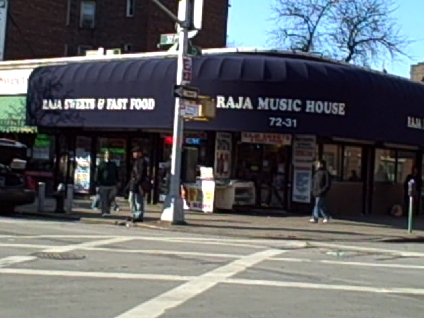From The Peopling of New York City
First Trip to Jackson Height's "Little India"
Visiting Jackson Height’s “Little India” was very reminiscent to Manhattan’s ethnic neighborhoods, like Chinatown and Little Italy. What struck me the most was how commercial this ethnic neighborhood was, and how it combined this market with many cultural establishments. To me, it seemed that a business’ level of commercial appeal depended on the customers they were attracting. For example, it appears that the jewelry stores had Hindi gods in their windows to attract religious customers; and being that jewelry is prevalently worn at wedding ceremonies, creating a religious and spiritual feel in the window’s appearance made sense. However, I was a bit confused as to why there were quite a few posters for astrologists and palm readers; until we talked about it in class, I believed that the purpose for these “tellers” were for entertainment, as many exist in Manhattan, not for confirming a marriage. Knowing this, these facts revealed to me that many of the Jackson Heights businesses cater to the wedding industry for a South Asian population. Since businesses such as sari and jewelry stores usually do not profit from the same customers frequently, as do restaurants and food markets, I wonder how these stores can survive relying solely on specific needs of South Asian families in the event of a wedding. I predict that they may attract customers far outside the Jackson Heights area in order to keep business alive.
For a very ethnic neighborhood that involves mostly South Asians, I was surprised at how pushy and “in-you-face” many of the employees of certain businesses attracted customers. For instance, South Asian men on the sidewalks advertised eyebrow threading to almost all the women walking past the beauty salon, while more workers handed out flyers for many of the clothing stores. Additionally, many businesses kept many of their products outside the buildings, had posters hanging from windows, or had large windows displaying their collection of movies, music, jewelry, etc. This image reminded me of midtown Manhattan, with the bright signs and advertisements, clusters of businesses, and people everywhere. Also, many businesses were seen above on the second floors of many buildings, or several were kept under the same awning, such as a “sweets and fast food” restaurant and a “music house.” Told that many establishments of varying businesses function under one owner, I wonder how many employers are able to successfully run these businesses and why they would choose to have more than one. In these difficult economic times, are South Asians looking to expand their businesses?
It is no question to me that South Asian businesses use their ethnicity to attract their customers; however, in seeing that certain businesses lure in either ethnic South Asians, other minorities and white people, or both, I wonder why they do so and what does this say about their particular business. For South Asian customers, are they instilling a cultural identity because of pride? For everyone else, are they eager to share their cultural with others? Do businesses care who is buying their goods at all and are more concerned with profit and survival? Does the commercialism of Little India have a depreciated or valued effect on the South Asian culture in New York?
--Edamasco 05:58, 9 February 2009 (UTC)


